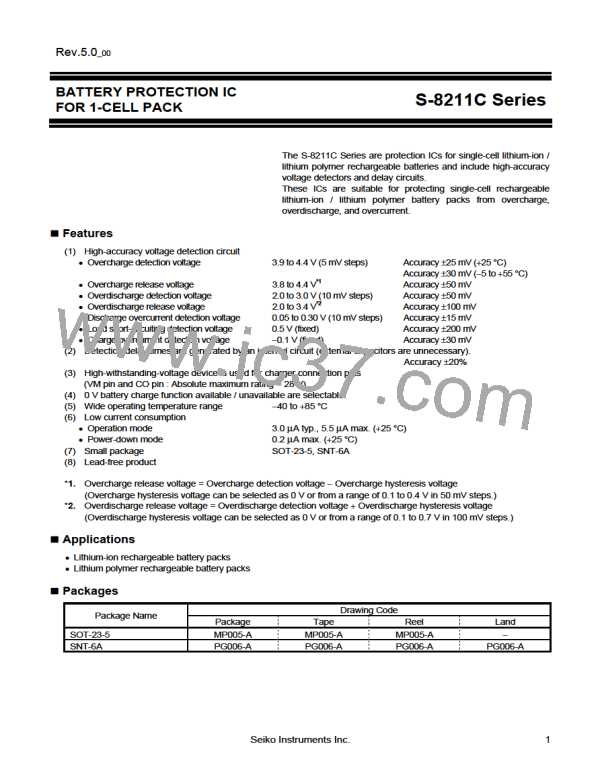BATTERY PROTECTION IC FOR 1-CELL PACK
S-8211C Series
Rev.5.0_00
Operation
Remark Refer to the “Battery Protection IC Connection Example”.
1. Normal Status
This IC monitors the voltage of the battery connected between the VDD pin and VSS pin and the voltage difference
between the VM pin and VSS pin to control charging and discharging. When the battery voltage is in the range from
overdischarge detection voltage (VDL) to overcharge detection voltage (VCU), and the VM pin voltage is in the range
from the charge overcurrent detection voltage (VCIOV) to discharge overcurrent detection voltage (VDIOV), the IC turns
both the charging and discharging control FETs on. This condition is called the normal status, and in this condition
charging and discharging can be carried out freely.
The resistance (RVMD) between the VM pin and VDD pin, and the resistance (RVMS) between the VM pin and VSS pin
are not connected in the normal status.
Caution When the battery is connected for the first time, discharging may not be enabled. In this case, short
the VM pin and VSS pin or connect the charger to restore the normal status.
2. Overcharge Status
When the battery voltage becomes higher than overcharge detection voltage (VCU) during charging in the normal
status and detection continues for the overcharge detection delay time (tCU) or longer, the S-8211C Series turns the
charging control FET off to stop charging. This condition is called the overcharge status.
The resistance (RVMD) between the VM pin and VDD pin, and the resistance (RVMS) between the VM pin and VSS pin
are not connected in the overcharge status.
The overcharge status is released in the following two cases ( (1) and (2) ).
(1) In the case that the VM pin voltage is higher than or equal to the charge overcurrent detection voltage (VCIOV),
and is lower than the discharge overcurrent detection voltage (VDIOV), S-8211C Series releases the overcharge
status when the battery voltage falls below the overcharge release voltage (VCL).
(2) In the case that the VM pin voltage is higher than or equal to the discharge overcurrent detection voltage (VDIOV),
S-8211C Series releases the overcharge status when the battery voltage falls below the overcharge detection
voltage (VCU).
The discharge is started by connecting a load after the overcharge detection, the VM pin voltage rises more than
the voltage at VSS pin due to the Vf voltage of the parasitic diode, because the discharge current flows through
the parasitic diode in the charging control FET. If this VM pin voltage is higher than or equal to the discharge
overcurrent detection voltage (VDIOV), S-8211C Series releases the overcharge status when the battery voltage is
lower than or equal to the overcharge detection voltage (VCU).
For the actual application boards, changing the battery voltage and the charger voltage simultaneously enables to
measure the overcharge release voltage (VCL). In this case, the charger is always necessary to have the
equivalent voltage level to the battery voltage. The charger keeps VM pin voltage higher than or equal to the
charge overcurrent detection voltage (VCIOV) and lower than or equal to the discharge overcurrent detection
voltage (VDIOV). S-8211C Series releases the overcharge status when the battery voltage falls below the
overcharge release voltage (VCL).
Caution 1. If the battery is charged to a voltage higher than overcharge detection voltage (VCU) and the
battery voltage does not fall below overcharge detection voltage (VCU) even when a heavy load is
connected, discharge overcurrent detection and load short-circuiting detection do not function
until the battery voltage falls below overcharge detection voltage (VCU). Since an actual battery
has an internal impedance of tens of mΩ, the battery voltage drops immediately after a heavy
load that causes overcurrent is connected, and discharge overcurrent detection and load short-
circuiting detection function.
2. When a charger is connected after overcharge detection, the overcharge status is not released
even if the battery voltage is below overcharge release voltage (VCL). The overcharge status is
released when the VM pin voltage goes over the charge overcurrent detection voltage (VCIOV) by
removing the charger.
Seiko Instruments Inc.
19

 SII [ SEIKO INSTRUMENTS INC ]
SII [ SEIKO INSTRUMENTS INC ]